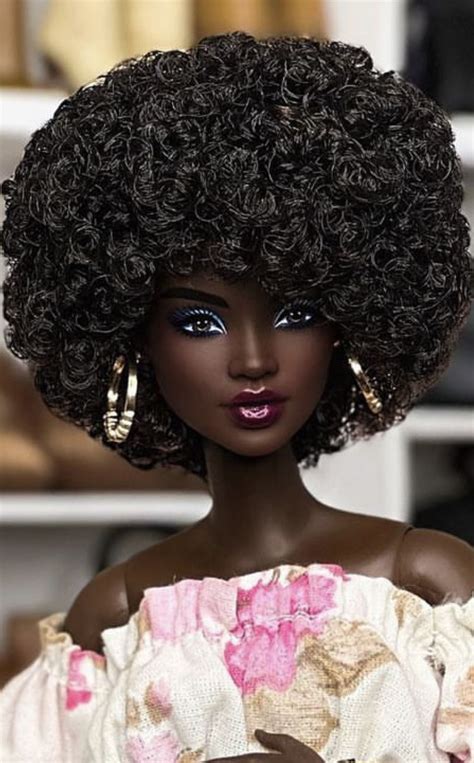Introduction

For decades, Barbie dolls have been icons of fashion and fun, but they have also faced criticism for their lack of diversity. In recent years, Mattel has made strides to address this issue, introducing a wider range of dolls with different skin tones, hair textures, and body types. Among these dolls, the Barbie dolls with black hair have become symbols of inclusivity and representation.
The Evolution of Black Hair Barbie Dolls
The first Barbie doll with black hair was released in 1967, but it took decades for Mattel to fully embrace diversity in its doll line. In the 1990s, the company began to introduce more black Barbie dolls, but these dolls were often marketed separately from the white dolls.
In 2009, Mattel took a major step forward when it launched the “Black Label Collection,” which featured a diverse range of black Barbie dolls designed by African American artists. These dolls were a huge success, and they helped to pave the way for even greater inclusivity in the Barbie line.
Today, Barbie dolls with black hair are available in a wide variety of styles and sizes. They can be found in the main Barbie line, as well as in specialty lines such as the Fashionistas and the Made to Move collections.
The Impact of Black Hair Barbie Dolls
The introduction of Barbie dolls with black hair has had a positive impact on young girls of color. These dolls provide them with a sense of representation and send the message that they are beautiful and worthy of being celebrated.
A study by the University of California, Los Angeles found that black girls who play with black Barbie dolls have higher self-esteem and are more likely to aspire to careers in science, technology, engineering, and math (STEM).
Another study, published in the journal “Pediatrics,” found that black girls who play with black Barbie dolls are less likely to experience body dissatisfaction and disordered eating.
The Benefits of Inclusivity
The inclusion of Barbie dolls with black hair is not only beneficial for young girls of color, but for all girls. It helps to create a more inclusive and tolerant society.
- Promotes diversity and acceptance: When children see dolls that reflect their own diversity, they learn to appreciate and accept differences in others.
- Reduces prejudice and discrimination: By exposing children to different cultures and races, Barbie dolls with black hair can help to reduce prejudice and discrimination.
- Inspires creativity and imagination: Barbie dolls with black hair can inspire children to create new and imaginative stories.
Strategies for Inclusion
Mattel has made significant progress in increasing the diversity of its Barbie line, but there is still more work to be done. Here are some strategies that Mattel can use to further promote inclusion:
- Increase the number of black Barbie dolls: The number of black Barbie dolls should be increased in the main Barbie line, as well as in specialty lines.
- Create more diverse characters: Mattel should create more black Barbie dolls with different hair textures, skin tones, and body types.
- Market black Barbie dolls inclusively: Mattel should market black Barbie dolls in a way that is inclusive and empowering.
Why Inclusion Matters
The inclusion of Barbie dolls with black hair is important for several reasons:
- It is a matter of representation: Black girls deserve to see themselves reflected in the toys they play with.
- It promotes self-esteem and aspiration: Black Barbie dolls can help black girls to develop positive self-esteem and to aspire to great things.
- It creates a more inclusive society: The inclusion of black Barbie dolls helps to create a more inclusive and tolerant society.
Conclusion
The introduction of Barbie dolls with black hair is a significant step forward for Mattel and for the toy industry as a whole. These dolls provide young girls of color with a sense of representation and empowerment, and they help to create a more inclusive and tolerant society.
FAQs
1. Why are there so few black Barbie dolls?
For many years, Mattel did not believe that there was a market for black Barbie dolls. However, in recent years, the company has realized the importance of diversity and has increased the number of black Barbie dolls in its line.
2. How can I find a black Barbie doll?
Black Barbie dolls can be found in the main Barbie line, as well as in specialty lines such as the Fashionistas and the Made to Move collections. You can also find black Barbie dolls online.
3. What is the best way to play with a black Barbie doll?
There is no right or wrong way to play with a black Barbie doll. Let your imagination guide you and have fun!
4. What are the benefits of playing with a black Barbie doll?
Playing with a black Barbie doll can help children to develop positive self-esteem, to aspire to great things, and to learn about different cultures.
5. How can I encourage my child to play with a black Barbie doll?
You can encourage your child to play with a black Barbie doll by talking about the doll’s unique features and by creating stories that feature the doll. You can also let your child choose the way they want to play with the doll.
6. What is the best way to care for a black Barbie doll?
To care for a black Barbie doll, gently wash it with soap and water and let it air dry. Avoid using harsh chemicals or detergents.
7. What is the average price of a black Barbie doll?
The average price of a black Barbie doll is between $10 and $20.
8. Where can I find more information about black Barbie dolls?
You can find more information about black Barbie dolls on the Mattel website and on other websites that focus on diversity in toys.
Tables
Table 1: Barbie Dolls with Black Hair (1967-2023)
| Year | Name | Description |
|---|---|---|
| 1967 | Christie | The first Barbie doll with black hair |
| 1980 | Shani | The first black Barbie doll with an Afro |
| 1999 | Asha | The first black Barbie doll with a non-Afro hairstyle |
| 2009 | Black Label Collection | A line of diverse black Barbie dolls designed by African American artists |
| 2016 | Fashionistas | A line of Barbie dolls with different skin tones, hair textures, and body types |
| 2018 | Made to Move | A line of Barbie dolls with extra articulation |
Table 2: Studies on the Impact of Black Hair Barbie Dolls
| Study | Findings |
|---|---|
| University of California, Los Angeles | Black girls who play with black Barbie dolls have higher self-esteem and are more likely to aspire to careers in STEM. |
| Pediatrics | Black girls who play with black Barbie dolls are less likely to experience body dissatisfaction and disordered eating. |
Table 3: Strategies for Inclusion
| Strategy | Description |
|---|---|
| Increase the number of black Barbie dolls | The number of black Barbie dolls should be increased in the main Barbie line, as well as in specialty lines. |
| Create more diverse characters | Mattel should create more black Barbie dolls with different hair textures, skin tones, and body types. |
| Market black Barbie dolls inclusively | Mattel should market black Barbie dolls in a way that is inclusive and empowering. |
Table 4: Benefits of Inclusion
| Benefit | Description |
|---|---|
| Promotes diversity and acceptance | When children see dolls that reflect their own diversity, they learn to appreciate and accept differences in others. |
| Reduces prejudice and discrimination | By exposing children to different cultures and races, Barbie dolls with black hair can help to reduce prejudice and discrimination. |
| Inspires creativity and imagination | Barbie dolls with black hair can inspire children to create new and imaginative stories. |
